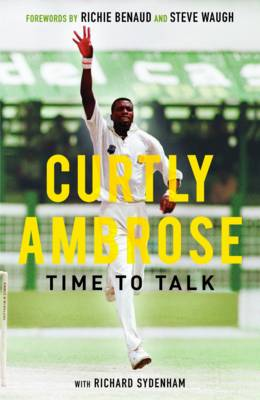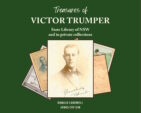Curtly Ambrose, Time to Talk
Archie Mac |Published: 2015
Pages: 282
Author: Sydenham, Richard
Publisher: Aurum
Rating: 4 stars

Some players are criticised for writing their biographies while they are still playing at the highest level, as they are contractually limited by what they can disclose. Curtly Ambrose, has waited almost 15 years since his last Test before putting pen to paper. The worry with this time lapse is that a whole generation of cricketing follows will only know Ambrose through his statistics and perhaps the odd highlight.
While his statistics are elite, bowling average 20.99, they do not convey the graceful run-up, or the cocked wrist with the white armbands. Or, most of all, the Ambrose intimidating stare. This book will help to add sweat and toil to the 400 plus wickets Ambrose claimed.
The title of the book “Time to Talk” is apt, as Ambrose did not give interviews during his playing career and rarely seemed to speak on the field. His co-author Richard Sydenham, does not appear to have interfered with Ambrose telling his life story. This means there is no need for a dictionary as the language is more like listening to a tell all interview.
With the style employed, at least you know the story is Ambrose’s own. In it he covers all of the controversial moments of his career and some rare insights into his thinking and motivation during his time as one of the finest fast bowlers to have played the game.
The Ambrose motivation seems to have been mostly based on pride. He provides a number of examples where he performed simply to prove others wrong for doubting his ability. The Ambrose pride leads to some questionable decisions by the great bowler; such as bowling three consecutive ‘beamers’ at Dermot Reeve in a county match. Ambrose justifies this by stating he did not like the way Reeve was coming down the wicket to the other bowlers, he was not silly enough to charge Ambrose.
Again seemingly with minimal justification for his own behaviour Ambrose sheds light on his heated clash with Steve Waugh, just when the West Indies lost grip on their cricking world crown. This footage of this incident shows Ambrose eyes rolling in the back of his head. After a torrid period where Ambrose beats him a number of times, Waugh goes on to play a match winning innings. His account of the Dean Jones episode when the Aussie batsman requested, through the umpires, that Ambrose remove his armbands is also compelling reading.
The only story that does not ring 100% true, is Ambrose’s explanation of why he bowled a number of consecutive no-balls in a match in Australia. Ambrose denies that he was deliberately overstepping the mark to bowl bouncers at the Aussie batsman and claims he just lost his radar. This was Ambrose’s last Test match in Australia and fittingly it was at the WACA where he claimed 24 wickets at 12.92 in just three Tests.
I did not gain those stats from his biography as the record section included is one of the most perfunctory to be found. This is a small criticism as Time to Talk moves at a fine pace (pun intended) and provides real insight to perhaps the finest fast bowler of them all and was well worth the 15 year wait.






Leave a comment